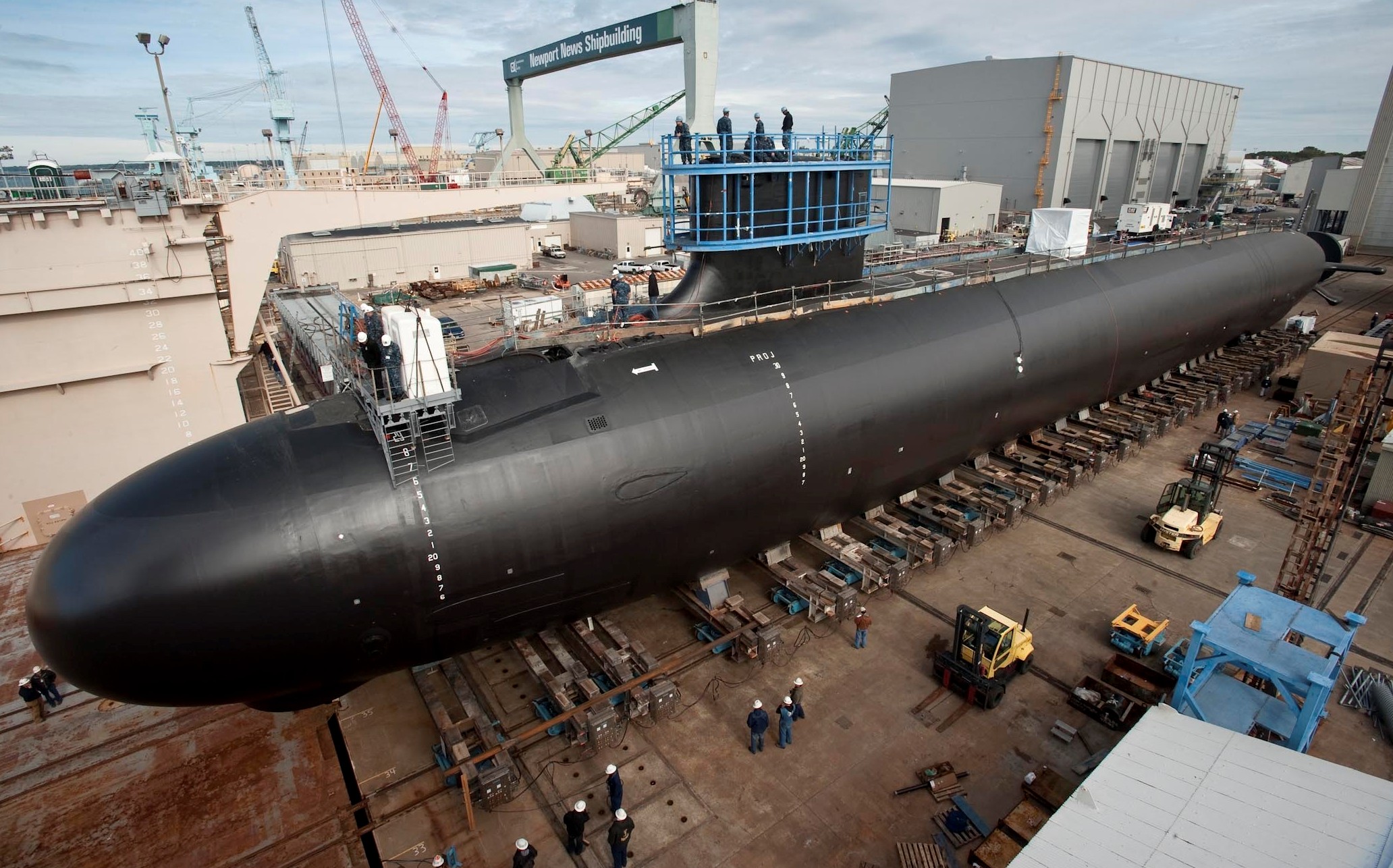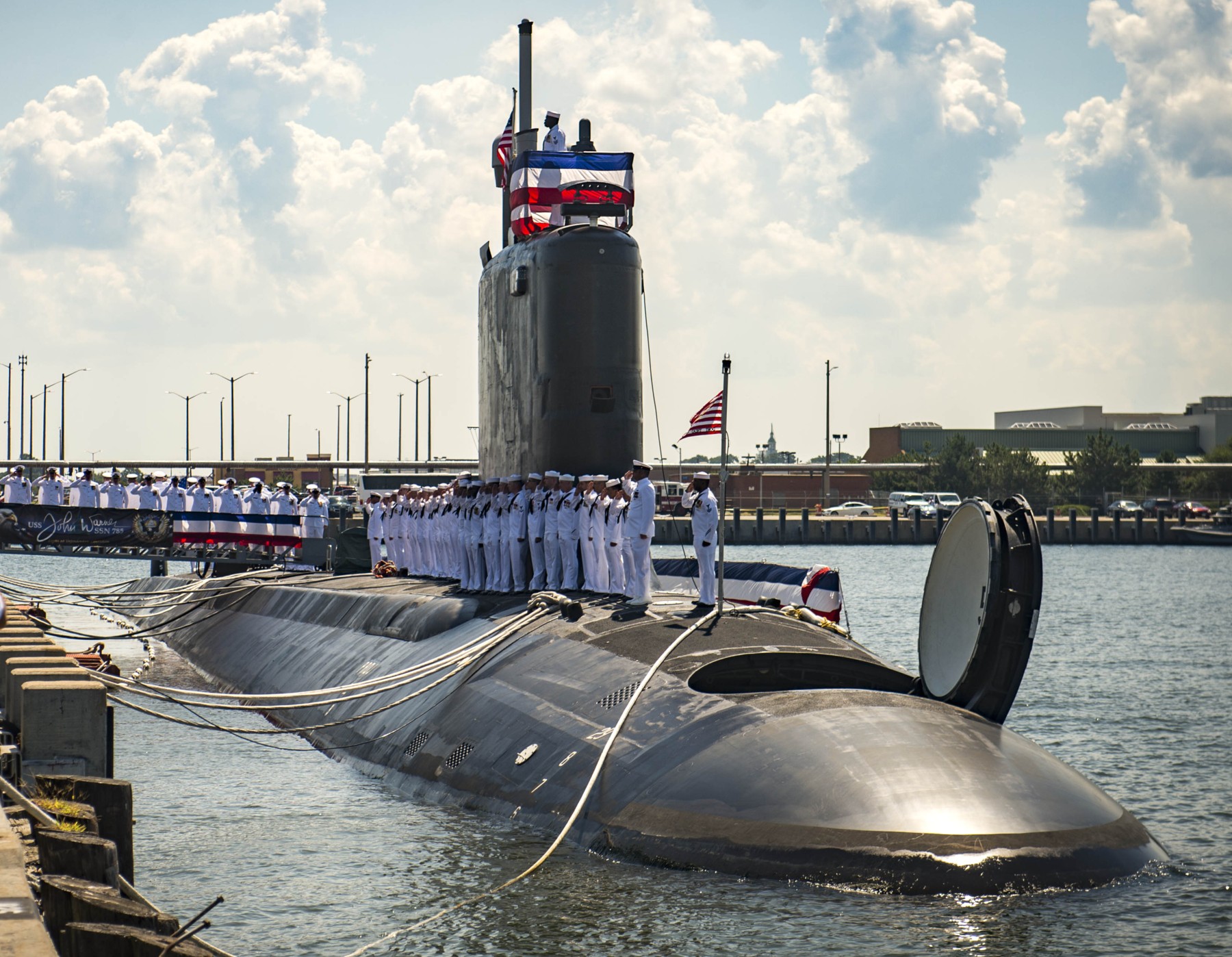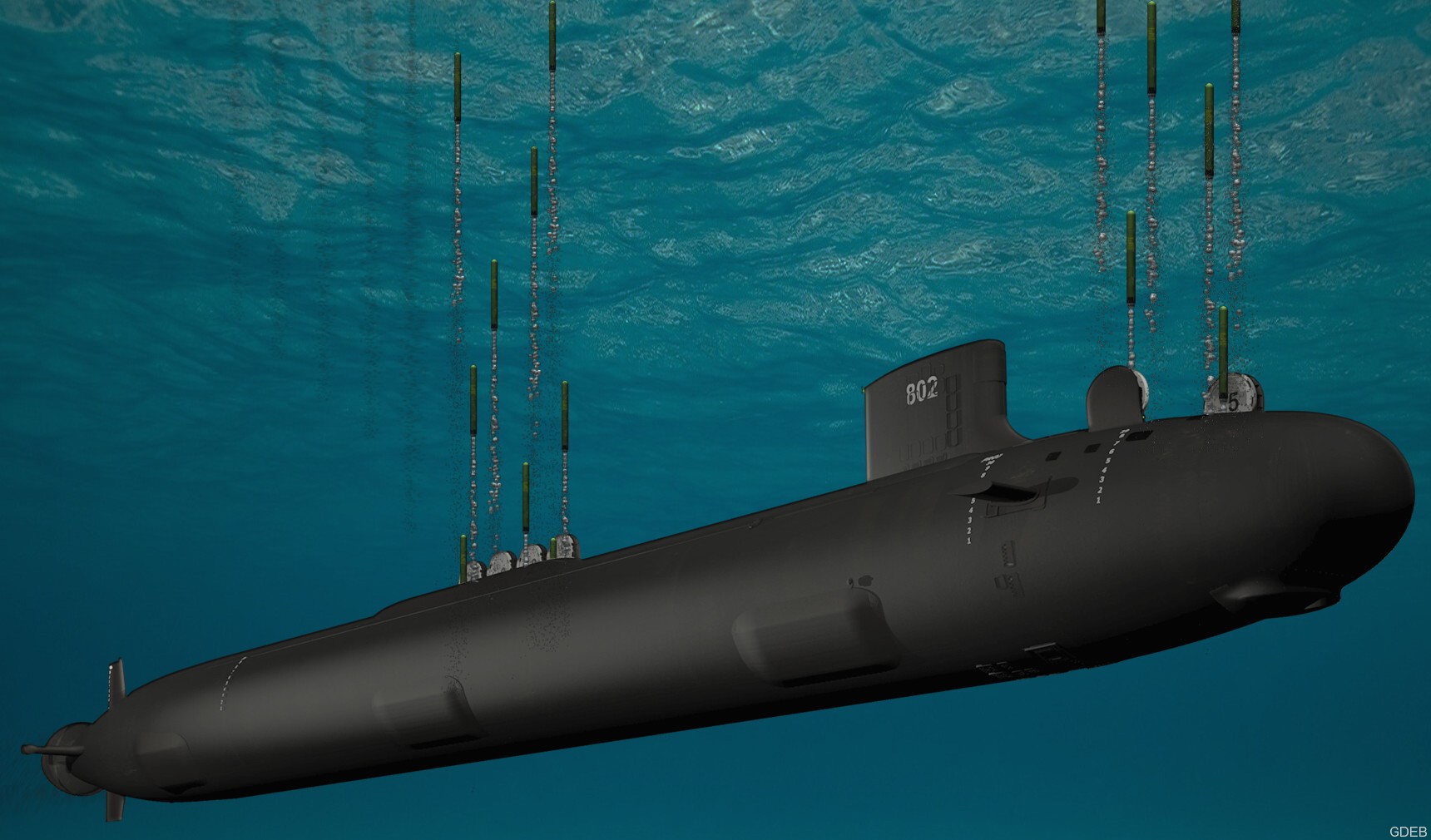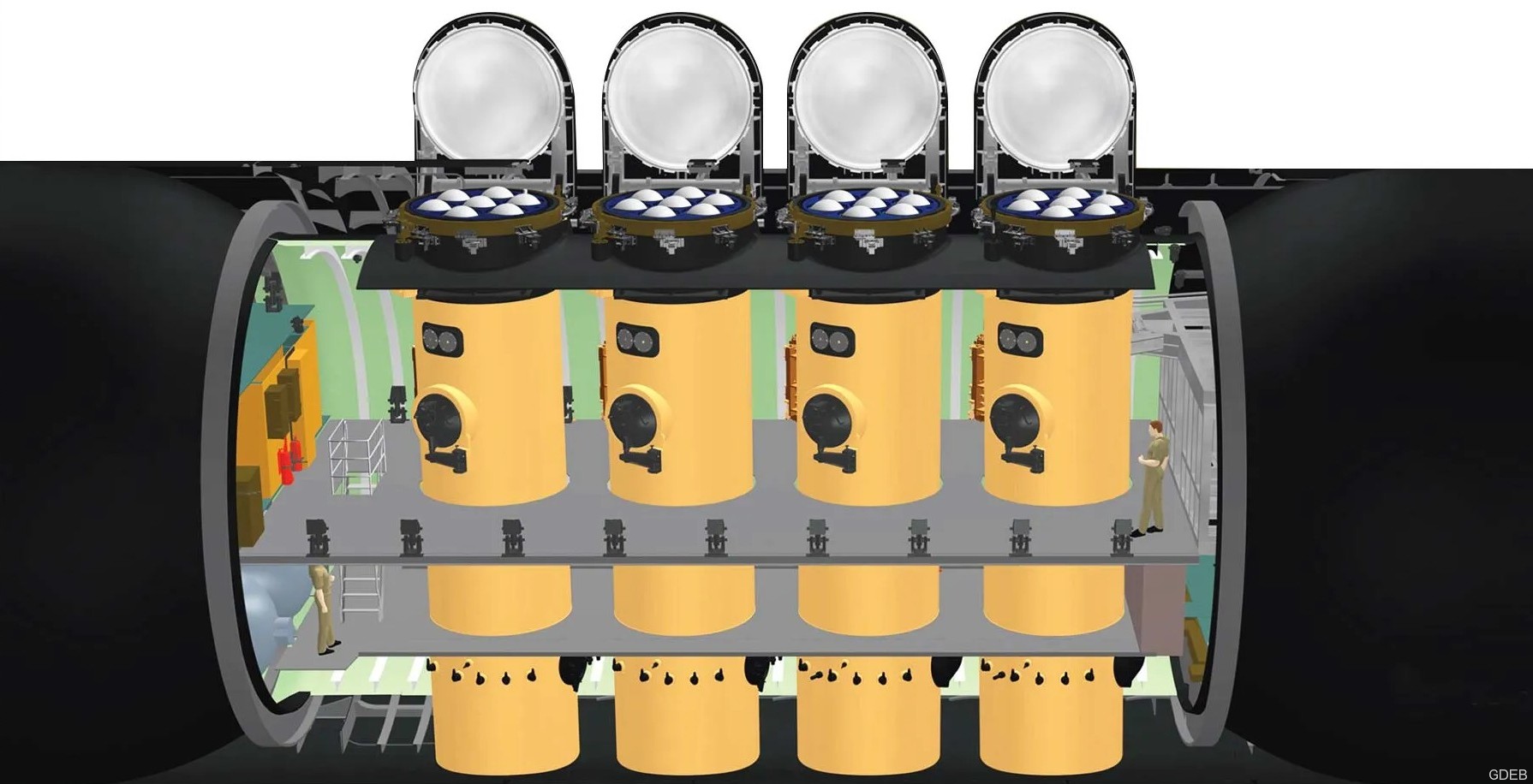|
|
|||||
|
HOME
|
US Navy -
ships
|
US Navy - air
units
|
USMC - air
units
|
International
Navies
|
Weapon Systems
|
Special Reports |
|||||
|
US Navy Virginia class Attack Submarine - SSN |
|||||
|
|
|||||
| 09/24 | |||||
| Units: | |||||
|
|||||
| Specifications: | |||||
|
Builders: General Dynamics Electric Boat, Groton, Connecticut, USA Huntington Ingalls Industries Newport News Shipbuilding, Virginia, USA Displacement: Block I-IV: 7900 tons / Block V: 10400 tons Length: Block I-IV: 115 meters (377 feet) / Block V: 140 m (460 ft) Beam: 10.36 meters (34 ft) Speed: 25+ knots (46+ km/h) Complement: 135 Propulsion: 1 x General Electric S9G nuclear reactor / 30MW delivering 40000 shp 1 shaft / 1 low-noise pump jet propulsor Armament: Block I&II: 4 x 21" (533mm) torpedo tubes for Mk.48 ADCAP torpedoes or mines 1 x Mk.45 Vertical Launching System / VLS (12 cells) for UGM-109 Tomahawk cruise missiles or UGM-84 Harpoon SSM Block III & IV: 4 x 21" (533mm) torpedo tubes for Mk.48 ADCAP torpedoes or mines 2 x Virginia Payload Tubes / VPT (6 cells, each) for UGM-109 Tomahawk cruise missiles or UGM-84 Harpoon SSM Block V: 4 x 21" (533mm) torpedo tubes for Mk.48 ADCAP torpedoes or mines 2 x Virginia Payload Tubes / VPT (6 cells, each) for UGM-109 Tomahawk cruise missiles or UGM-84 Harpoon SSM 4 x Virginia Payload Module / VPM (7 cells, each) for UGM-109 Tomahawk cruise missiles or UGM-84 Harpoon SSM = 40 cells in total + torpedoes |
|||||
|
The Virginia class is built through an
industrial arrangement designed to keep both General Dynamics
Electric Boat and HII Newport News Shipbuilding (the only two U.S.
shipyards capable of building nuclear-powered vessels) in the
submarine-building business. Under the present arrangement, the
Newport News facility builds the stern, habitability, and machinery
spaces, torpedo room, sail, and bow, while Electric Boat builds the
engine room and control room. The facilities alternate work on the
reactor plant as well as the final assembly, test, outfit, and
delivery. The Virginia class incorporates several innovations not found in previous US submarine classes: Unified Modular Masts: For the first time in history the design of the eight masts in Virginia class has been unified in a Universal Modular Mast (UMM) program led by L3 KEO (previously Kollmorgen): shared components have been maximized and some design choices are also shared between different masts. The first UMM was first installed on USS Memphis, a Los Angeles-class submarine. The UMM is an integrated system for housing, erecting, and supporting submarine mast-mounted antennas and sensors. The UMMs are: • Snorkel mast • Two photonic masts • Two (tactical) communication masts • One or two high-data-rate satellite communication (SATCOM) masts, built by Raytheon, enabling communication at Super High Frequency (for downlink) and Extremely High Frequency (for uplink) range • Radar mast (carrying AN/BPS-16 surface search and navigation radar) • Electronic warfare mast (AN/BLQ-10 Electronic Support Measures) used to detect, analyze, and identify both radar and communication signals from ships, aircraft, submarines, and land-based transmitters Photonics masts: The Virginia class is the first to utilize photonic sensors instead of a traditional periscope: the class is equipped with high-resolution cameras, along with light-intensification and infrared sensors, an infrared laser rangefinder, and an integrated Electronic Support Measures (ESM) array. Two redundant sets of these sensors are mounted on two AN/BVS-1 photonics masts located outside the pressure hull. Signals from the masts' sensors are transmitted through optical fiber data lines through signal processors to the control center. Visual feeds from the masts are displayed on liquid-crystal display interfaces in the command center. The design of earlier optical periscopes required them to penetrate the pressure hull, reducing the structural integrity of the pressure hull as well as increasing the risk of flooding, and also required the submarine's control room to be located directly below the sail/fin. Implementation of photonics masts (which do not penetrate the pressure hull) enabled the submarine control room to be relocated to a position inside the pressure hull which is not necessarily directly below the sail. The current photonics masts have a visual appearance so different from the ordinary periscopes that when the submarine is detected, it can be distinctly identified as a Virginia-class vessel. As a result, current photonic masts will be replaced with Low-Profile Photonics Masts (LPPM) which resemble traditional submarine periscopes more closely. In the future, a non-rotational Affordable Modular Panoramic Photonics Mast may be fitted, enabling the submarine to obtain a simultaneous 360° view of the sea surface. Propulsor: In contrast to a traditional bladed propeller, the Virginia class uses pump-jet propulsors (built by BAE Systems), originally developed for the Royal Navy's Swiftsure-class submarines. The propulsor significantly reduces the risks of cavitation, and allows quieter operation. Improved sonar systems: Sonar arrays aboard Virginia-class submarines have an "Open System Architecture" (OSA) which enables rapid insertion of new hardware and software as they become available. Hardware upgrades (dubbed Technology Insertions) are usually carried out every four years, while software updates (dubbed Advanced Processor Builds) are carried out every two years. Virginia-class submarines feature several types of sonar arrays. • BQQ-10 bow-mounted spherical active/passive sonar array (Large Aperture Bow (LAB) sonar array from SSN-784 onwards) • A wide aperture lightweight fiber optic sonar array, consisting of three flat panels mounted low along either side of the hull • Two high frequency active sonars mounted in the sail and bow. The chin-mounted (below the bow) and sail-mounted high frequency sonars supplement the (spherical/LAB) main sonar array, enabling safer operations in coastal waters, enhancing under-ice navigation, and improving anti-submarine warfare performance. • Low-Cost Conformal Array (LCCA) high frequency sonar, mounted on both sides of the submarine's sail. Provides coverage above and behind the submarine. Virginia-class submarines are also equipped with a low frequency towed sonar array and a high frequency towed sonar array. • TB-16 or TB-34 fat line tactical towed sonar array • TB-29 or TB-33 thin line long-range search towed sonar array Rescue equipment: • SEIE MK11 suit(s) - enable ascent from a sunken submarine (maximum ascent depth 600 feet) • lithium hydroxide canisters that remove carbon dioxide from the submarine's atmosphere • Submarine Emergency Position Indicating Radio Beacon (SEPIRB) Virginia Payload Module: The Block III+IV submarines have two multipurpose Virginia Payload Tubes (VPT) replacing the dozen single purpose cruise missile launch tubes. The Block V submarines built from 2019 onward will have an additional Virginia Payload Module (VPM) mid-body section, increasing their overall length. The VPM will add four more VPTs of the same diameter and greater height, located on the centerline, carrying up to seven Tomahawk missiles apiece, that would replace some of the capabilities lost when the SSGN conversion Ohio-class submarines are retired from the fleet. Initially eight payload tubes/silos were planned but this was later rejected in favor of four tubes installed in a 70-foot (21 m) long module between the operations compartment and the propulsion spaces. The VPM could potentially carry (non-nuclear) medium-range ballistic missiles. Adding the VPM would increase the cost of each submarine by $500 million (2012 prices). This additional cost would be offset by reducing the total submarine force by four boats. More recent reports state that as a cost reduction measure the VPM would carry only Tomahawk SLCM and possibly unmanned undersea vehicles (UUV) with the new price tag now estimated at $360-380 million per boat (in 2010 prices). The VPM launch tubes/silos will reportedly be similar in design to the ones planned for the Ohio class replacement. In July 2016 General Dynamics was awarded $19 million for VPM development. In February 2017 General Dynamics was awarded $126 million for long lead time construction of Block V submarines equipped with VPM. The VPM was designed by General Dynamics Electric Boat; however, manufacturing is undertaken by BWX Technologies and BAE Systems. Other improved equipment: • Optical fiber fly-by-wire Ship Control System replaces electro-hydraulic systems for control surface actuation. • Command and control system module (CCSM) built by Lockheed Martin. • The auxiliary generator is powered by a Caterpillar model 3512B V-12 marine diesel engine. This replaced the Fairbanks-Morse diesel engine, which would not fit in Virginia’s auxiliary machinery room. • Modernized version of the AN/BSY-1 integrated combat system designated AN/BYG-1 (previously designated CCS Mk2) and built by General Dynamics AIS (previously Raytheon). AN/BYG-1 integrates the submarine Tactical Control System (TCS) and Weapon Control System (WCS). • USS California was the first Virginia-class submarine with the advanced electromagnetic signature reduction system built into it, but this system is being retrofitted into the other submarines of the class. • Integral 9-man lock-out chamber. Block I: Modular construction techniques were incorporated during construction. Earlier submarines (e.g., Los Angeles-class SSNs) were built by assembling the pressure hull and then installing the equipment via cavities in the pressure hull. This required extensive construction activities within the narrow confines of the pressure hull which was time-consuming and dangerous. Modular construction was implemented in an effort to overcome these problems and make the construction process more efficient. Modular construction techniques incorporated during construction include constructing large segments of equipment outside the hull. These segments (dubbed rafts) are then inserted into a hull section (a large segment of the pressure hull). The integrated raft and hull section form a module which, when joined with other modules, forms a Virginia-class submarine. Block I boats were built in 10 modules with each submarine requiring roughly 7 years (84 months) to build. Block II: Block II boats were built in four sections rather than ten sections, saving about $300 million per boat. Block II boats (excluding SSN-778) were also built under a multi-year procurement agreement as opposed to a block-buy contract in Block I, enabling savings in the range of $400 million ($80 million per boat). As a result of improvements in the construction process, New Hampshire was 500 million USD cheaper, required 3.7 million fewer labor hours to build (25% less) thus shortening the construction period by 15 months (20% less) compared to Virginia. Block III: SSN-784 through approximately SSN-791 are planned to make up the Third Block or "Flight" and began construction in 2009. Block III subs feature a revised bow with a Large Aperture Bow (LAB) sonar array, as well as technology from Ohio-class SSGNs (2 VLS tubes each containing 6 missiles). The horseshoe-shaped LAB sonar array replaces the spherical main sonar array which has been used on all U.S. Navy SSNs since 1960. The LAB sonar array is water-backed - as opposed to earlier sonar arrays which were air-backed - and consists of a passive array and a medium-frequency active array. Compared to earlier Virginia-class submarines about 40% of the bow has been redesigned. South Dakota (SSN-790) will be equipped with a new propulsor, possibly the Hybrid Multi-Material Rotor (HMMR), developed by Defense Advanced Research Projects Agency (DARPA). The Hybrid Multi-Material Rotor program is an attempt to improve the design and manufacturing process of submarine propellers with an aim of reducing the cost and weight of the propeller/rotor as well as improving overall acoustic performance. Block IV: Block IV consists of 10 submarines. The 2013 budget sequestration put this 10-submarine in doubt by budget sequestration that same year. The most costly shipbuilding contract in history, worth $17.6 billion, was awarded on 28 April 2014 to General Dynamics Electric Boat. The main improvement over the Block III is the reduction of major maintenance periods from four to three, increasing each boat's total lifetime deployments by one. The long-lead-time materials contract for SSN-792 was awarded on 17 April 2012, with SSN-793 and SSN-794 following on 28 December 2012. The U.S. Navy has awarded General Dynamics Electric Boat a $208.6 million contract modification for the second fiscal year (FY) 14 Virginia-class submarine, SSN-793, and two FY 15 submarines, SSN-794 and SSN-795. With this modification, the overall contract is worth $595 million. Block V: Block V has 10 boats and may incorporate the Virginia Payload Module (VPM), which would give guided-missile capability when the SSGNs are retired from service. The Virginia Payload Module will be included on Block V submarines starting with the second boat, SSN-803. The Block V boats with VPM are expected to triple the capacity of shore targets for each boat. Construction on the first two boats of this block was expected to begin in 2019 but was pushed back to 2020, with contracts for long lead time material for SSN-802 and SSN-803 being awarded to General Dynamics Electric Boat. HII Newport News Shipbuilding was awarded a long-lead materials contract for two Block V boats in 2017, the first Block Vs for the company. On 2 December 2019, the Navy announced an order for nine new Virginia-class submarines - eight Block Vs and one Block IV - for a total contract price of $22 billion with an option for a tenth boat. The Block V subs were confirmed to have an increased length, from 377 ft (115 m) to 460 ft (140 m), and displacement, from 7,800 tons to 10,200 tons. This would make the Block V the second-longest US submarine, behind only the Ohio-class submarines (at 560 ft; 170 m). On 22 March 2021, the U.S. Navy added the 10th boat of the Block V series of the Virginia-class attack submarine, issuing a $2.4 billion adjustment on the December 2019 contract. This brings the total cost of the contract with prime contractor General Dynamics Electric Boat to $24.1 billion. The net increase for the contract is $1.89 billion, according to a General Dynamics release. Huntington Ingalls Industries' Newport News Shipbuilding is the partner yard in the program. source: wikipedia |
|||||
|
class & detail
images for more images go to the individual boat's page |
|||||
 Block I  Block I  Block I  Block II  Block II  Block II  Block III  Block III  Block III  Block III  Block IV  Block V  4 x 7-cell Virginia Payload Module (VPM) in Block V boats from SSN 803 onwards  US Navy info sheet a look inside             |
|||||
| | seaforces.org | USN ships start page | |
